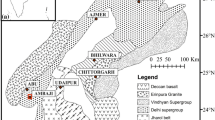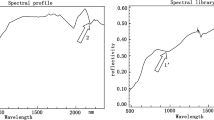Abstract
Mapping in the areas, which are near the collision zone, needs extensive and exact studies and tools because of the variety of rocks and complex structures. Hyperspectral sensor is one of the most advanced tools that can do imaging in hundreds of delicate and continuous bands in visible and infrared spectrums. Therefore, it can identify many lithologies despite spectral similarities and complications. In the present study, as one of the first hyperspectral data survey for separating ophiolite melange units in Iran, we applied the spectral-based method of neutral network classification method on hyperion images of Tabas in southeast of Iran. Based on various laboratory–field studies, the lithology of the study area can be separated into five general groups: ophiolite series, metamorphic units, Oligocene–Miocene to Quaternary volcanic units, and lime and flysch units. In order to perform an accuracy assessment of the image processing results, some locations and points were sampled. These samples were analyzed under the microscope and by electron microprobe system. Based on field–laboratory works, the accuracy of the resulting image was validated. Consequently, the neutral network method as advanced hyperspectral image processing method produced an average user accuracy coefficient of 62 % in some parts of colored mélanges. Therefore, the method based on neutral network theory for spectral classification has acceptable ability to discriminate various lithologies in the complex geological scenarios.










Similar content being viewed by others
References
Alavipenah Sk (2008) Modern remote sensing principles and interpretation of satellite and aerial photos. Institute of Tehran University, 385 p
Arvin M, Robinson PT (1994) The petrogenesis and tectonic setting of lavas from the Baft ophiolitic mélange, southwest of Kerman, Iran. Can J Earth Sci 31:824–834
Bahrambeygi B, Ranjbar H, Shahabpour J (2012) Comparison of statistical based and spectral based methods on Hyperion image processing–case study detection Argillic zone in region of Masahim Volcano. Iranian economic geology journal, Ferdosi publication, v2, 199–215 p
Beiranvand Pour A, Hashim M (2011) The Earth Observing-1 (EO-1) satellite data for geological mapping, southeastern segment of the Central Iranian Volcanic Belt, Iran. Int J Phys Sci 6(33):7638–7650
Bindschadler R, Choi H (2003) Characterizing and correcting Hyperion detectors using ice-sheet images. IEEE Trans Geosci Remote Sens 41(6):1189–1193
Brocker M, Fotoohi Rad GR, Thunissen S (2011) New time constraints for HP metamorphism and exhumation of mélange rocks from the Sistan suture zone, eastern Iran. An abstract paper in Turkey Symposium: Tectonic Crossroads: Evolving Orogens of Eurasia–Africa–Arabia
Bucher K, Frey M (1994) Petrogenesis of metamorphic rocks, 6th edn. Springer, Heidelberg. 318P
Camp VE, Griffis RJ (1982) Character, genesis, and tectonic setting of igneous rocks in the Sistan Suture Zone, eastern Iran, Lithos, 15:221–239 p
Clark RN, Swayze GA, Gallagher AJ, King TVV, Calvin WM (1993) The U.S. Geological Survey, Digital Spectral Library: Version 1: 0.2 to 3.0 microns, U.S. Geological Survey Open File Report 93–592, 1340 p
Coops NC, Smith ML, Martin ME, Ollinger SV, Held AA (2002) Predicting eucalypt biochemistry from HYPERION and HYMAP imagery. In Proc. IGARSS, Toronto, ON, Canada
Felde GW, Anderson GP, Adler-Golden SM, Matthew NW, Berk A (2003) Analysis of Hyperion data with the FLAASH atmospheric correction algorithm. Proceedings of the International Geoscience and Remote Sensing Symposium (IGARSS). Toulouse, 21–25 July 2003, pp.90-92
Fotoohi Rad GR, Droop GTR, Burgess R (2009) Early cretaceous exhumation of high-pressure metamorphic rocks of the Sistan Suture Zone, eastern Iran. Geological Journal
Fotouhirad Gh (1996) A study of petrology, petrography and geochemistry of ophiolite mélange of north west of Drah region (southeast of Birjand) with a view on the region's economic potential. Master Thesis, Department of Geology, Tarbiat Moallem University, Tehran, page 230
Fotouhirad Gh (2004) Petrology and geochemistry of metamorphosed ophiolitic of East of Birjand. Education Ph.D. dissertation, Department of Geology, Tarbiat Moallem University, Tehran, 323 pages
Gersman R, Ben-Dor E, Beyth M, Avigad D, Abraha M, Kibreab A (2008) Mapping of hydrothermally altered rocks by the EO-1Hyperion sensor, northern Danakil Depression, Eritrea. Int J Remote Sens 29:3911–3936
Ghazi AM, Hassanipak AA, Mahoney JJ, Duncan RA (2004) Geochemical characteristics, 40Ar/39Ar ages and original tectonic setting of the Band-e Zeyar-at Anar ophilite, Makran accretionary prism, S.E. Iran. Tectonophysics 393:175–196
Gomes-Pugnair MT et al (2003) The amphibolite from the Ossena-Morena /Central Iberian Variscan suture (Southwestern Iberian Massif): geochemistry and tectonic interpretation. Lithos 68:23–42
GoodarziMehr S, Abbaspour RA, Ahadnejad V, Khakbaz SB (2012) Compared to the maximum likelihood method, support vector machine and neural network methods for the separation of lithological units. Quarterly Geological Survey of Iran 6(22):75–92
Hubbard BE, Crowley JK, Zimbelman DR (2003) Comparative alteration mineral mapping using visible to shortwave infrared (0.4–2.4 μm) Hyperion, ALI, and ASTER imagery. IEEE Trans Geosci Remote Sens 41(6):1401–1410
Khurshid KS, Staenz K, Sun L, Neville R, White HP, Bannari A, Champagne CM, Hitchcock R (2006) Preprocessing of EO-1 Hyperion data. Can J Remote Sens 32(2):84–97
Kruse FA (2003) Preliminary results—hyperspectral mapping of coral reef systems using EO-1Hyperion, Buck Island, U.S. Virgin Islands: In proceedings 12th JPL Airborne Geoscience Workshop, Jet Propulsion Laboratory, Publication 04–6 (CD-ROM), p. 157 – 173
Kruse FA, Bordman JW, Huntington JF (2003) Comparison of airborne hyperspectral data and EO-1 Hyperion for mineral mapping. IEEE Trans Geosci Remote Sens 41(6):1388–1400
Leverington DW (2008) Discrimination of geological end members using Hyperion imagery: preliminary results, Big Bend National Park, Texas. IEEE International Geosciences and Remote Sensing Symposium, Boston, Massachusetts
Pearlman JS, Barry PS, Segal CC, Shepanski J, Beiso D, Carman SL (2003) Hyperion, a space borne imaging spectrometer. IEEE Trans Geosci Remote Sens 41(6):1160–1173
Ramsey E III, Rangoonwala A, Nelson G, Ehrlich R, Martella K (2004) Generation and validation of characteristic spectra from EO-1 Hyperion image data for detecting the occurrence of the invasive species, Chinese tallow. Int J Remote Sens 26:1611–1636
Richard JA (1999) Remote Sensing Digital Image Analysis, Springer-Verlag, Berlin. In: Schrader S, Pouncy R, (ed) 1997 ERDAS Field Guide. 4th ed. ERDAS, Inc. Atlanta, GA, p. 240
ShakerArdakani AR, Arvin M, Oberhänsli R, Mocek B, Moeinzadeh SH (2009) Morphology and petrogenesis of pillow lavas from the Ganj ophiolitic complex, Southeastern Kerman, Iran. J Sci 2(20):139–151, Islamic Republic of Iran
Staenz K, Neville RA, Clavette S, Landry R, White HP (2002) Retrieval of surface reflectance from Hyperion radiance data. IEEE Geosci Remote Sens Lett 1:1419–1421
Theunissen S, Bröcker M, Fotoohi Rad GhR (2011) HP metamorphism in the Sistan Suture Zone eastern Iran, New insights from Rb-Sr data. Symposium of Turkey
Tirrul R, Bell IR, Griffis RJ, Camp VE (1983) The Sistan Suture Zone of eastern Iran. Geological Society of America Bulletin V. 94, P.134-150,12
Weber-Diefenbach K, Davoudzadeh M, Alavi-Tehrani N, Linsch G (1984) Paleozoic ophiolites in Iran, geology and geochemistry, and geodynamic implication. Ofioliti 11:305–383
Wijaya A, (2005) Application of multi-stage classification to detect illegal logging with the use of multi-source data, MSc. Thesis, ITC, Enschede, The Netherlands
Author information
Authors and Affiliations
Corresponding author
Rights and permissions
About this article
Cite this article
Moeinzadeh, H. Hyperspectral mapping of Iranian east ophiolite mélanges using neutral network classification method. Arab J Geosci 8, 2169–2178 (2015). https://doi.org/10.1007/s12517-014-1333-y
Received:
Accepted:
Published:
Issue Date:
DOI: https://doi.org/10.1007/s12517-014-1333-y




